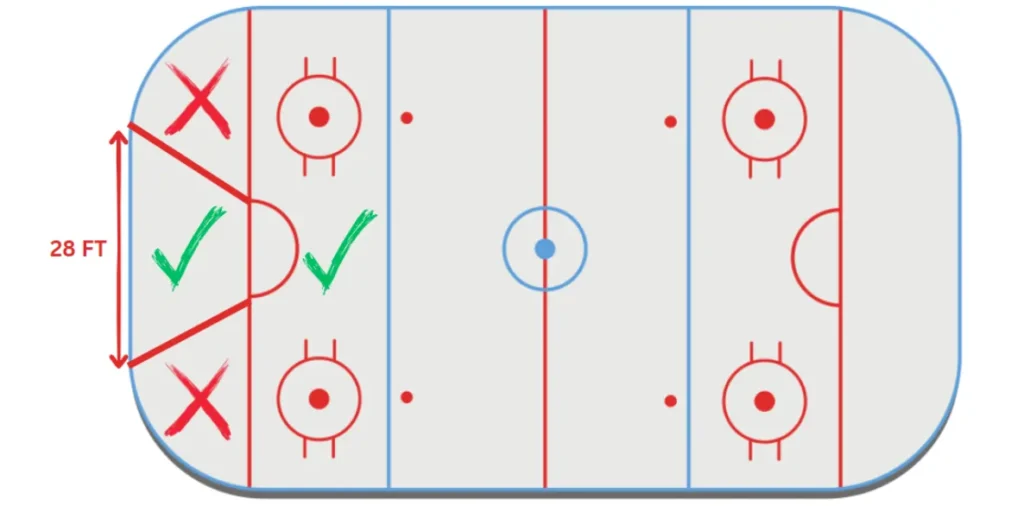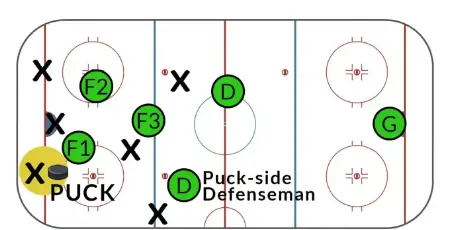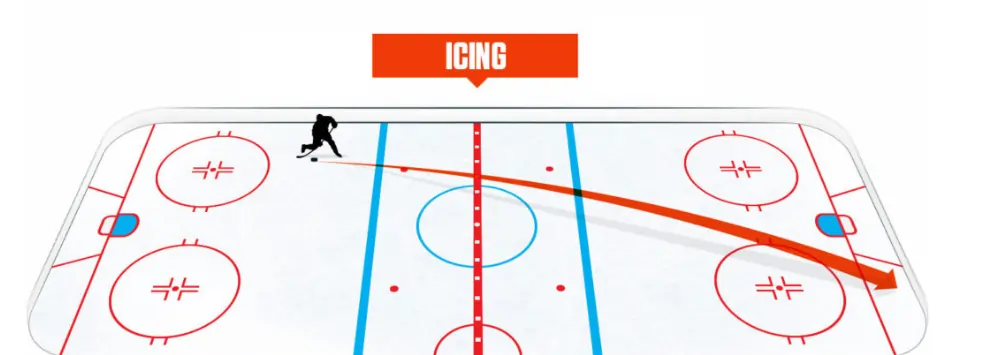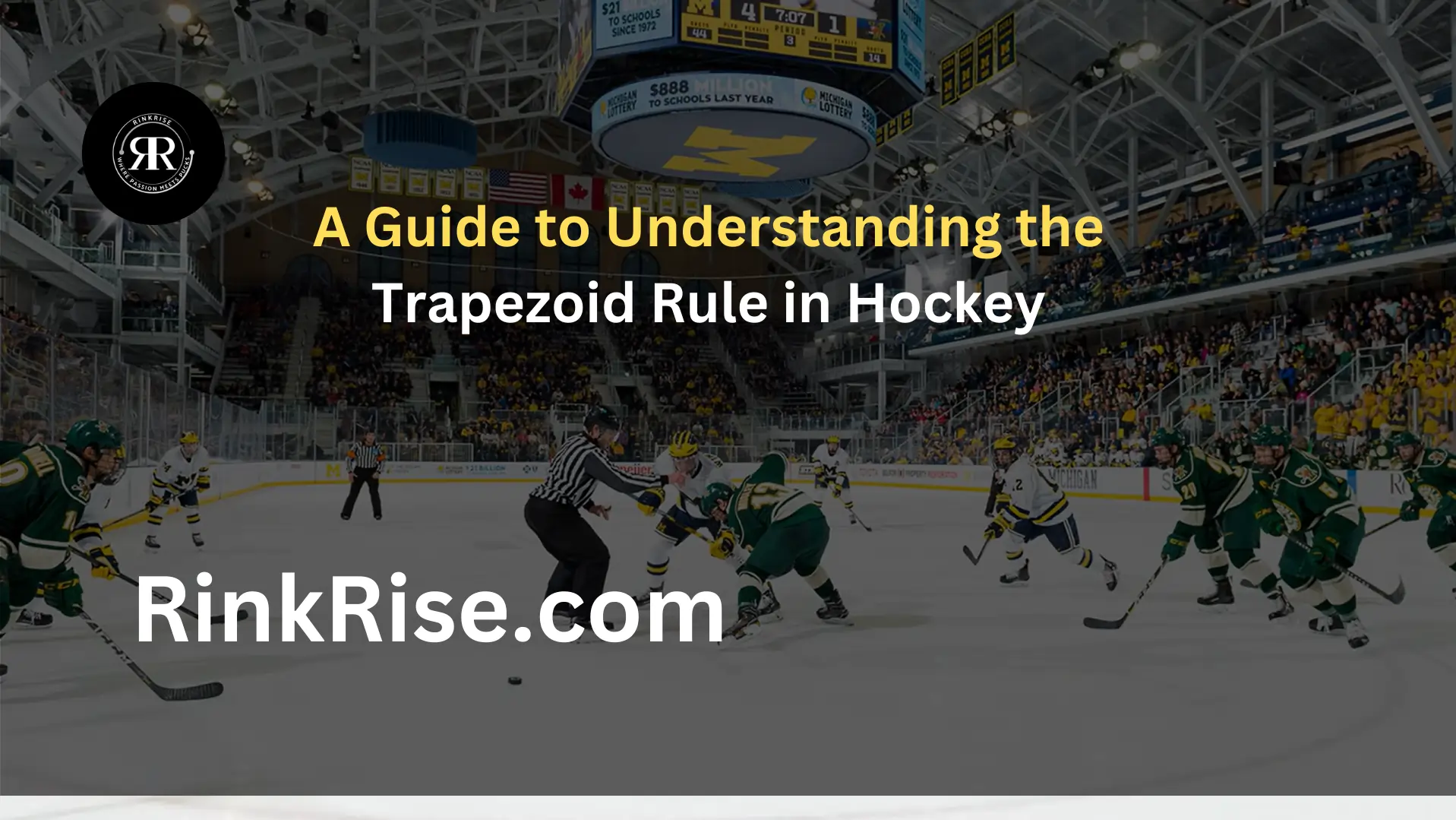In hockey, the area known as “the trapezoid” is a critical space behind the goal lines and net. This designated area is crucial as it outlines where goaltenders are allowed to interact with the puck. It is formed by two diagonal lines that begin six feet from the goalposts and stretch to a width of 28 feet at the end boards. This zone is exclusively for the goalie to handle the puck; if they play the puck outside this area, they risk giving the opposing team a power play.
Understanding the NHL Trapezoid Rule: Simplifying Ice Hockey Regulations
In today’s ice hockey world, the trapezoid area is a game-changer, significantly altering both the goalie’s strategies and the overall team play. This marked zone behind the net isn’t just for show; it fundamentally transforms gameplay. Our detailed guide breaks down the NHL trapezoid rule, making its complexities accessible and understandable to enthusiasts of all ages.
By viewing the sport through this rule, we can see its profound impact on each exciting moment in hockey. This exploration aims to enlighten and engage everyone, ensuring they grasp how this rule reshapes the game.

The Evolution of the Hockey Trapezoid Rule
Instituted following the 2004-2005 NHL lockout, the trapezoid rule was adopted in the 2005-2006 season to create a fairer gameplay dynamic by restricting the goaltender’s influence in distributing the puck. This adjustment was specifically designed to reduce the goalie’s capacity to interact with the puck behind the net, thus facilitating smoother offensive maneuvers by opposing teams, particularly during strategies that involve dumping the puck into the opponent’s zone and chasing after it.
Understanding the Hockey Trapezoid Rule
The hockey trapezoid rule, commonly known as the NHL trapezoid regulation, is a crucial part of ice hockey that primarily governs the movements of the goalkeeper.
This rule delineates a specific green-colored area located behind the goal line and around the goalkeeper’s net, serving as an essential boundary.
Within this trapezoid, the goalkeeper may handle the puck freely without incurring a penalty. However, should the goalkeeper handle the puck outside this zone, particularly beyond the goal line, they are subject to a two-minute penalty.
Origins of the Hockey Trapezoid
The introduction of the hockey trapezoid was a significant change that reshaped ice hockey.
During the 1980s, ice hockey was known for its high-scoring games, with legends like Mario Lemieux and Wayne Gretzky breaking scoring records. However, as the league expanded in the 1990s, the increase in teams led to a diluted talent pool, and many teams adopted a defensive strategy known as the neutral zone trap.
This strategy prioritized defense, capitalizing on opponents’ errors to score. Consequently, this led to a noticeable decrease in scoring, with goals per game dropping by 30-40% during the late 1990s and early 2000s, a period often referred to as the “dead puck era.”
Reviving Hockey Interest: Tackling the Dead Puck Era
In response to the 2004–2005 NHL lockout and a noticeable decline in fan enthusiasm, a rules committee was formed to enhance offensive play.
A significant change that emerged from various adjustments aimed at increasing scoring was the implementation of the trapezoid area behind the net. This innovation has been pivotal in transforming gameplay to encourage more scoring opportunities.

The Impact of the NHL Trapezoid Rule on Offensive Play
Before the introduction of the NHL Trapezoid Rule, goalkeepers were quite skilled at handling the puck outside their crease, retrieving it, and quickly passing it to their defenders. This skill significantly hindered the opposing team’s ability to maintain control in the offensive zone.
A common offensive strategy involves shooting the puck into the corner or around the boards to outmaneuver defenders or provoke errors. However, as goalkeepers improved at intercepting these pucks, this tactic became less effective.
As a result, the primary method left for attacking teams was to carry the puck over the blue line into the offensive zone. This approach proved challenging, as defenders often fortified the blue line, complicating the attackers’ entry. The Trapezoid Rule was introduced to curb the goalie’s puck-handling abilities, thereby reviving this offensive strategy and enhancing overall game dynamics.
Enhancing Game Dynamics with the Trapezoid Rule
The introduction of the trapezoid has significantly altered ice hockey by restricting the goalkeeper’s area to handle the puck. This limitation makes it tougher for goalkeepers to assist their defense in quickly clearing the puck.
By confining the goalkeeper’s play to this specific area, the rule enhances the offensive team’s ability to regain possession by targeting areas that are less accessible to the goalkeeper.
Consequently, this change has improved the effectiveness of forechecking and increased the offensive team’s opportunities to maintain control of the puck.
Read also: How Many Periods In Hockey? (The Best Quick Guide)
Exploring the Brodeur Rule in Ice Hockey
Often termed the Brodeur Rule, the trapezoid rule in ice hockey honors legendary goalkeeper Martin Brodeur.
During his tenure with the New Jersey Devils, especially in the trap era, Brodeur’s exceptional skills contributed to multiple Stanley Cup victories, earning him a place in the ice hockey hall of fame.
The Devils were renowned for their mastery of the neutral zone trap, and Brodeur was celebrated as one of the league’s top goalkeepers.

Assessing the Scoring Impact of the Trapezoid Rule
Following the 2004-2005 lockout season, changes to the rules, including the trapezoid rule, have been instrumental in increasing scoring, although quantifying its exact impact on scoring remains challenging.
These adjustments have made hockey more exciting by facilitating faster gameplay and effectively countering the neutral zone trap, enhancing the overall pace and thrill of the game.
Criticisms of the Trapezoid Rule in Hockey
The trapezoid rule in ice hockey has not only influenced gameplay positively but has also drawn several criticisms:
- Increased Risk of Injuries: Restricting the goalkeeper’s ability to assist defensemen has led to concerns about more collisions and potential injuries.
- Challenges for Goaltenders: Goalkeepers who engage in offensive plays may find themselves in unfamiliar situations, leading to unpredictable outcomes and mistakes.
- Encourages Dump and Chase: The rule compels teams to rely more on launching the puck into corners and battling for possession, which can detract from more creative passing strategies.
- Confusion Among Fans: The additional lines and zones can make the game harder for new or casual fans to understand.
Despite these points, the broader benefits of the trapezoid rule should be considered. It mitigates the effectiveness of the neutral zone trap, thereby making the game faster and more offensively driven. In the broader scope of ice hockey, the trapezoid has been a pivotal change, influencing both defensive and offensive tactics and ushering in a new phase of dynamic, strategic gameplay.
Implementation of the Trapezoid Rule in NHL
The NHL introduced the trapezoid rule, often known as the goalkeeper trapezoid, in the 2005-2006 season to enhance scoring opportunities.
Under this rule, goalkeepers are restricted to handling the puck only within the trapezoid area, with penalties for violations.
This change aimed to prevent goalkeepers from acting as a third defenseman and to encourage more offensive play by limiting their ability to control the pace of the game.
Conclusion on the NHL Trapezoid Rule
The NHL’s trapezoid rule has reshaped ice hockey by limiting goalkeepers’ puck-handling abilities, promoting faster gameplay, and encouraging more offensive strategies. Despite some criticisms, this rule significantly impacts the sport’s dynamics, enhancing the excitement and competitiveness of games.
FAQ’s: Hockey’s Trapezoid Rule
What is the NHL trapezoid rule?
Since the 2005–06 NHL season, a trapezoid-shaped area has been marked behind each goalie net. Goalies are restricted to handling the puck within this area or in front of the goal line to regulate game play and limit the goalie’s influence outside their immediate vicinity.
What are the dimensions of the trapezoid in hockey?
The designated trapezoid area behind the net is restricted for the goalie’s puck play. This area extends from lines starting six feet (6′) from each goal post and stretching diagonally to points twenty-eight feet (28′) apart on the end boards.
Can you check the goalie in the trapezoid?
Players are generally not allowed to make contact with the goalie within the crease, unless the puck is present there. Outside the crease, incidental contact might be permitted if it happens during a legitimate attempt to play the puck.
Why is it called the trapezoidal rule?
The term “trapezoidal rule” is used because the method involves dividing the area under a curve into small trapezoids rather than rectangles. The area of these trapezoids is then calculated over a specific interval to estimate the total area under the curve. This approach helps in achieving a more accurate approximation compared to using rectangles.
What determines the height of a trapezoid?
The height of a trapezoid is defined as the perpendicular distance between its two parallel sides, known as the bases. Calculating this height can be approached in two ways: one method is used when the area of the trapezoid is known, and another method applies when the area is unknown.




ТОП-овое рекламное digital агентство предлагает комплексные решения для товаров и услуг в любой сфере бизнеса. Эффективные стратегии продвижения, команда.